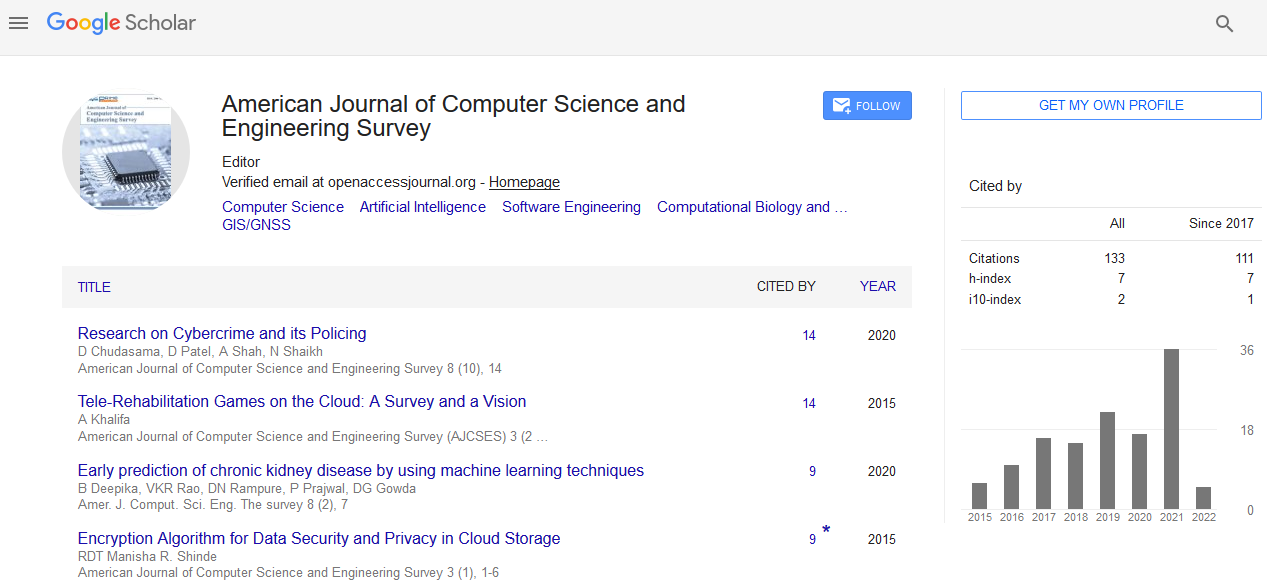Opinion - (2022) Volume 10, Issue 4
Objectives of DVFS Technique in Mobile Edge Computing
Ali Asghari*
Department of Environmental Sciences, Wageningen University, Netherlands
*Correspondence:
Ali Asghari,
Department of Environmental Sciences, Wageningen University,
Netherlands,
Tel: 8541279630,
Email:
Received: 29-Jun-2022, Manuscript No. IPACSES-22-14443;
Editor assigned: 01-Jul-2022, Pre QC No. IPACSES-22-14443(PQ);
Reviewed: 15-Jul-2022, QC No. IPACSES-22-14443;
Revised: 20-Jul-2022, Manuscript No. IPACSES-22-14443(R);
Published:
27-Jul-2022, DOI: 10.36846/2349-7238-10.4.16
Introduction
Today, versatile distributed computing is broadly utilized
by portable clients. The rise of the Web of Things, savvy urban
communities, business associations, web based gaming,
e-learning, and web based business has driven cloud specialist
organizations to zero in on this area. The improvement of savvy
cell phones and his 5G organization are speeding up the utilization
of these administrations. To work on the nature of administration
and lessen the inertness of getting to assets, cloud
specialist co-ops have drawn assets nearer to the edge of cloud
clients and organizations. These waiters are found near his CBS
(Cell Base Station) radio wire so clients can undoubtedly get to
them with satisfactory postponements. Then again, portable
shrewd gadgets have restricted handling power and little energy
limit, so high handling based undertakings are offloaded to
contiguous edge waiters. The re-appropriating process is either
incomplete or parallel. The previous kind offloads part of the
interaction, while the last option model offloads the whole cycle
to an edge server. Appropriate arrangement of cloud assets
is basic because of the portability of versatile clients and different
assistance prerequisites in various areas.
Description
Server situation ought to be founded on the different assistance
necessities of each zone. Some business habitats and
occupied regions have high exchanges, while others have moderate
or low demands. In this way, the appropriate geological
situation of cloud assets will further develop asset effectiveness
and work on the nature of administration that clients get.
Legitimate arrangement of cloud servers can likewise enhance
the energy utilization of cloud assets and decrease asset access
dormancy. There are different ways to deal with server situation
in MEC (Versatile Edge Processing), including: Diminished
inactivity, better burden adjusting, more effective utilization of
assets, decreased energy utilization and client costs. Clearly,
because of the enormous number of MEC servers, computing all potential mappings among servers and locales to find
the best arrangement is either unimaginable or takes a ton of
time, so to tackle this utilizes meta-heuristics and enhancement
strategies. Upgrading MEC server energy utilization and
lessening access dormancy are two vital objectives of these
organizations. Cloud specialist co-ops will generally lessen the
energy utilization of their servers, bringing about lower costs.
Then again, clients need less dormancy in getting to assets,
particularly for online applications. This works on the nature of
administration gave to clients. Thus, the proposed method was
done in light of a legitimate concern for the two players. A few
single-and multi-objective streamlining calculations have been
presented lately by specialists in the field of server sending. For
populace based streamlining procedures, transient intricacy
improves and the probability of non-union increments as the
populace size increments.
Conclusion
The utilization of learning calculations is likewise exceptionally
reliant upon the dimensionality of the issue. For instance, support
learning and Q-learning become altogether less proficient
as the issue space develops. This issue additionally applies to
grouping techniques. With these methods, notwithstanding
versatility issues, having a place with a bunch is significant and
legitimate situation of all assets isn’t fundamentally important.
One method for diminishing the intricacy of the issue is to partition
the area into more modest zones and use parallelization
strategies. Utilizing profound brain organizations and game
hypothesis, all neighborhood arrangements can be joined to
worldwide spot them. In any case, the brain network preparing
cycle can turn into a bottleneck with countless data sources,
which can prompt overtraining. Additionally, in game hypothesis,
the union of the issue is exceptionally reliant upon the
quantity of players and may not scale as the quantity of players
increments. The proposed technique utilizes novel metaheuristic
calculations called TSR and DVFS strategies to conquer existing
difficulties.
Citation: Asghari A (2022) Objectives of DVFS Technique in Mobile Edge Computing. J Aquat Pollut Toxicol. 10:16.
Copyright: © 2022 Asghari A. This is an open-access article distributed under the terms of the Creative Commons Attribution
License, which permits unrestricted use, distribution, and reproduction in any medium, provided the original author and source
are credited.

